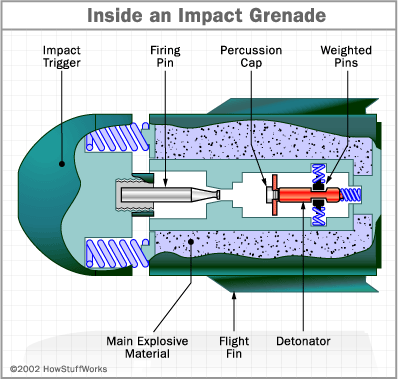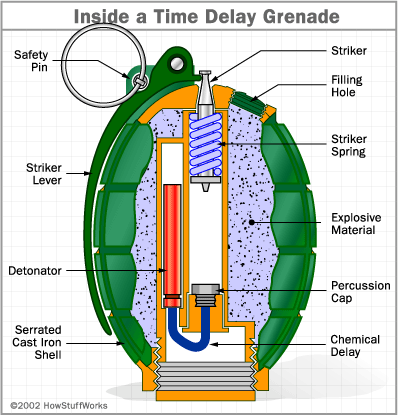|
|
|
| GRENADES | |
|
|
|
 |
Grenades have played a part in warfare for hundreds of years. They were originally developed around 1000 AD by the Chinese, just one application of their revolutionary gunpowder technology. Europeans came up with their own versions in the 15th and 16th centuries, with mixed results.
The typical design of these early grenades was a hollow metal container filled with gunpowder. Soldiers simply lit a wick and tossed the grenade -- as fast as they could. By the 18th century, these weapons had fallen out of favor: They weren't especially useful in the battle style of the time, and the simple design made them extremely dangerous. The weapon saw a resurgence in the 20th century with the development of new modes of combat. In the trench warfare of World War I, soldiers could use grenades to take out machine gunners without ever revealing themselves to the enemy. Thanks to mechanical ignition systems that made the weapons relatively practical and safe, grenades took their place as an indispensable element in modern warfare. |
 |
Impact Grenades
Impact Grenades Impact grenades work like a bomb launched from an airplane -- they explode as soon as they hit their target. Typically, soldiers don't throw impact grenades as they would a time-delay grenade. Instead, they use a grenade launcher to hurl the grenade at high speed. U.S. ground forces typically use grenade launchers that attach to assault rifles. In one conventional gun-mounted launcher design, grenades are propelled by the gas pressure generated by firing a a blank cartridge. Some launcher grenades have their own built-in primer and propellant. Afghan fighters and many other forces around the world use rocket-propelled grenade launchers, once mass produced by the Soviet Union. Like missiles, these grenades have a built-in rocket propulsion system. Impact grenades must be unarmed until they are actually fired because any accidental contact might set them off. Since they are usually shot from a launcher, they must have an automatic arming system. In some designs, the arming system is triggered by the propellant explosion that drives the grenade out of the launcher. In other designs, the grenade's acceleration or rotation during its flight arms the detonator. The grenade has an aerodynamic design, with a nose, a tail and two flight fins. The impact trigger, at the nose of the grenade, consists of a movable, spring-mounted panel with an attached firing pin facing inward. As in the time-delay grenade, the fuze mechanism has a percussion cap and a detonator explosive that ignites the main explosive. But it does not include a chemical delay element.When the grenade is unarmed, the fuze mechanism is positioned toward the tail end, even though it has a spring pushing it toward the nose. It is held in this position by several spring-mounted, weighted pins. The firing pin is not long enough to reach the percussion cap when the fuze is in this position. If the trigger plate is pressed in accidentally, the pin will slide back and forth in the air, and nothing will happen. When the grenade is fired it begins to spin (like a well-thrown football). This motion is caused by the shape and position of the fins, as well as spiraled grooves inside the barrel of the grenade launcher. The spinning motion of the grenade generates a strong centrifugal force that pushes the weighted pins outward. When they move far enough out, the pins release the fuze mechanism, and it springs forward toward the nose of the grenade. When the grenade hits the ground, the nose plate pushes in, driving the firing pin against the percussion cap. The cap explodes, igniting the detonator explosive, which ignites the main explosive. There are dozens of variations on this idea, some with much more elaborate arming and ignition systems. But the basic principle in most of these weapons is the same. In the future, grenade mechanisms will continue to evolve. Already, some modern grenades use an electronic fuze system instead of a mechanical or chemical fuze. In time-delay electronic grenades, the fuze consists of a digital clock and an electrically operated firing pin. When the firing button or lever is activated, the electronic system starts a precise timer. At the end of the count, the fuze mechanism releases the firing pin. Since it uses an actual clock instead of a combination of chemicals, this timing system is much more accurate than conventional fuzes. |
 |
Time-Delay Grenade
Time-Delay Grenade The most common type of grenade on the battlefield is the time-delay fragmentation anti-personnel hand grenade. The primary function of this grenade is to kill or maim nearby enemy troops. To ensure maximum damage, the grenade is designed to launch dozens of small metal fragments in every direction when it explodes. These sorts of grenades, which played a major role in World War I, World War II, Vietnam and many other 20th century conflicts, are designed to be durable, easy to use and easy to manufacture. The conventional design uses a simple chemical delay mechanism. The diagram below shows a typical configuration of this system, dating back to the first World War. |